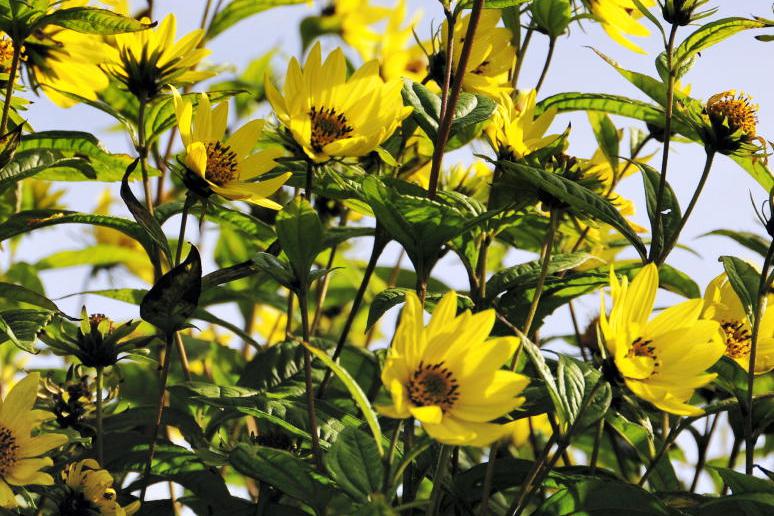Name: Perennial sunflower, Lemon Queen.
Botanical name: Sunflower is one of those plant names that have the same meaning in botanical Latin as they do in English. Sunflower, like some other flowers, has the ability to track the sun across the sky in the course of the day. This warmth helps to encourage pollinating insects to visit the flowers and to remain longer on them. The botanical name for sunflower is Helianthus, from the Greek for sun, helios, and Latin for flower.
Family: The sunflowers are part of the large daisy family, the Compositae, so named because the flowers are made up of smaller, composite flowers. The central disc is composed of individual florets, while the outside ring flowers are colourful, much larger, and act as a signal to pollinating insects. The Compositae are also known as the Asteraceae, named after Aster, which is the type species for the daisy family.
Garden value
The familiar sunflower, the one that brings a smile to people’s faces is such a cheery plant. Children are especially fond of it, as it is fun to grow, and it is widely grown and popular.
But the giant sunflower is an annual and lasts only one summer. Seeds must be sown each year. However, the sunflower has perennial cousins that last for many years and flower profusely each summer and autumn.
While a lot of flowers are produced by these perennial cousins, the flowers are smaller in size than the giant sunflower which can reach more than 30cm across. What they lack in size, they make up in numbers and the plants carry lots of bright yellow flowers, many more than the annual sunflower.
Like the giant sunflower, they make big plants with stems to 2m and more. So they need to be well placed in the garden, especially if space is limited. Tucked away at the back of a border, their tall stems will wave with golden sunflowers for many weeks in late summer and early autumn.
In fact, they have a great autumnal air to them, the yellow daisy flowers setting off the autumn colour of leaves. This works fabulously with dark blue monkshood.
One of the very best is ‘Lemon Queen’, growing to about 1.5m tall. This variety has lots of relatively small flowers, though still about 8cm across, carried over the top half of the plant from late summer through into autumn.
The colour is a brighter lemon-yellow than most sunflowers, which tend to be deep yellow. The flowers of ‘Lemon Queen’ are of a very pretty shape, with petals nicely arranged
‘Capenoch Star’ is about 1.5m tall too, also with lemon-yellow flowers and the flower centres made composed of quill-shaped florets.
‘Triomphe de Gand’ has large rich deep-yellow sunflowers, with a darker centre.
In the popular variety, ‘Loddon Gold’, the flowers are fully rounded out as double flowers. ‘Soleil d’Or’ also has full, double flowers, not as rounded as the other and of nicer shape.
Growing perennial sunflowers
These named types are relatively well-behaved, spreading out by means of rhizomatous stems to make a clump but reasonably slowly and they are easily controlled. Even so they are on the large side for many gardens, but are worth the space for their bright flowers late in the season. Any of the perennial sunflowers can be planted in autumn or spring in any ordinary garden soil. Match them up with shrubs or perennial flowers of similar vigour.
Some recent strong gales have brought down apples prematurely, particularly the cooking apple variety, ‘Bramley’s Seedling’. But also the old reliable disease-free variety ‘Lord Lambourne’.
It can be difficult to find uses for heavy falls of fruits, many too damaged by falling to store without rotting. If a press or large-scale juicer is available, juice or cider can be made, but otherwise it can be very difficult to make good use of windfalls. If there are fruit still on the trees, they might be picked before they fall, and stored in plastic bags to keep them from shrivelling.

The fallen apples have great value for wildlife. All sorts of animals from foxes to small slugs even late-flying butterflies can find food in fallen apples. Birds, especially blackbirds, can be sustained by fallen apples and they usually pick out the pulp, leaving just the skin. There is a risk of carryover of brown rot disease to next year’s crop, so pick out and dispose of or bury rotted fruit with white spots.
Fruit, vegetables and herbs
Late autumn is an ideal time to plant new fruit trees and bushes. Dig over vegetable ground, removing old crops to the compost heap. Control weeds over areas of ground that will be dug over later. Spread compost and rotted manure before digging it in.
Lawn
If moss has been a problem, sulphate of iron can be used now. Even though grass growth has slowed, occasional mowing is a good idea if the soil is not too wet. Grass tends to grow a little over winter and an occasional mowing will keep it right.
Trees, shrubs and roses
Planting of bare-root deciduous trees, hedging and shrubs can continue in good weather. Do not plant into wet ground or into planting holes that fill with water, because the wet conditions cause the roots to rot. Pot-grown trees and shrubs can also be planted.
Flowers
Spring bulbs can still be planted but do not delay if possible. Tulips and alliums tolerate late planting. Bedding plants for spring colour should be put in. Lift dahlias, begonias and gladiolus in frosty localities to prevent damage, or cover them with soil.
Greenhouse and house plants
Remove all debris and dead plants and ventilate occasionally. Water very little to reduce the risk of grey mould disease. Set up a greenhouse frost protection heater to protect tender plants, such as geraniums or fuchsias. Be careful not to over-water house plants.






 This is a subscriber-only article
This is a subscriber-only article











SHARING OPTIONS: